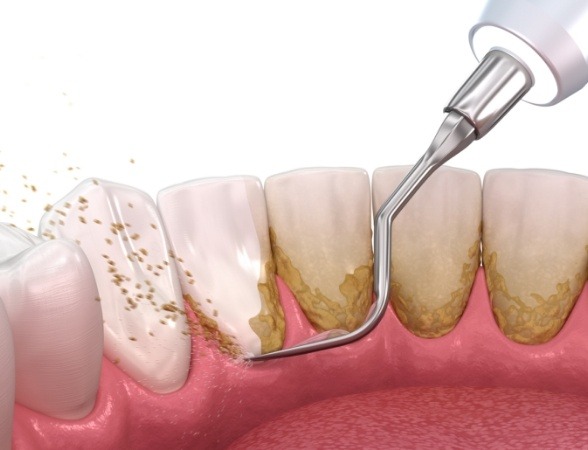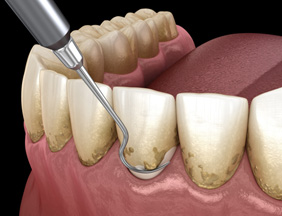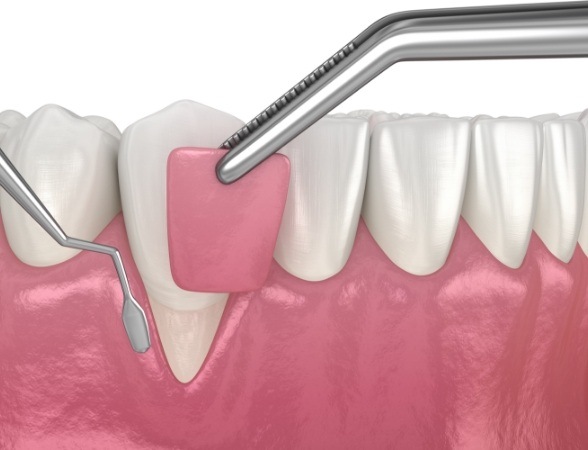Periodontal Disease Treatment – Carrollton, TX
Heal Your Gums & Preserve
Your Pearly Whites
Your teeth might take center stage when you smile, but they need healthy gums to support them. When plaque and bacteria build up and infect the gums, you might experience swelling, soreness, inflammation, and even bleeding when you brush or floss. Left untreated, gum disease could even permanently damage the structures keeping your teeth in place, resulting in tooth loss! That’s why Dr. Anthony Dillard offers periodontal disease treatment in our Carrollton, TX dental office to heal your gums and preserve your pearly whites. Call our dental office today to schedule the gentle treatment your gums need!
Why Choose Anthony Dillard, DDS Family & Cosmetic Dentistry for Periodontal Disease Treatment?
- Several Dental Sedation Options to Soothe Your Nerves
- Relaxing, Spa-Like Dental Office Atmosphere
- Partners with an Expert Periodontist for Gum Grafting
Scaling & Root Planing

The gold standard for gum disease treatment is a two-pronged procedure called scaling and root planing. First, we use special instruments to break down plaque deposits that have gathered along and below the gumline, where your toothbrush and floss cannot reach. Then, with root planing, we smooth the rough surfaces of your teeth’s roots. Not only does root planing prompt your gums to reattach to your teeth, but it also lowers your risk of reinfection because bacteria have difficulty accumulating on smooth surfaces.
Do You Need Scaling & Root Planing?

To determine whether scaling and root planing is right for you, we will complete an examination of your mouth. X-rays will also be captured to collect as much information as possible. Depending on the condition of your gums, the depth of your gum pockets, and the progression of your gum disease, we may recommend scaling and root planing.
The Process of Scaling & Root Planing

A complete scaling and root planing treatment is usually completed over the course of a couple of visits. However, treatment length can vary for each patient. To remove plaque and tartar, your dentist will start by scaling the teeth with dental tools. They will target the gumline and beneath the gumline where bacteria build up.
After the scaling portion is complete, your dentist will move ono to the root planing portion. This is when they smooth down sections of the teeth beneath the gumline to help them adhere to the teeth. This helps to speed up the healing process making it more challenging for the bacteria to build up again. Ultimately, this process reduces your risk of developing gum disease again.
Aftercare Tips for Scaling & Root Planing

It is normal for your gums to feel sore following scaling and root planing. Your gums may also be a little bit inflamed. This is temporary following your treatment and should go away within a couple of weeks. Here are a few tips to help the health process go quickly and smoothly.
- Brush your teeth twice a day with a soft bristled toothbrush and fluoridated toothpaste.
- Rinse your mouth with saltwater after meals.
- Floss thoroughly every day.
- Stick to a soft diet following your treatment.
- Avoid foods and beverages that are spicy, acidic, or hot.
- Refrain from intense physical activity following your treatment.
Gum Grafting

Advanced gum disease often causes the gums to recede, which leaves the sensitive tooth roots vulnerable to infection and damage. While receded gum tissue cannot grow back, gum grafting can protect these exposed sections of the teeth for a healthier (and better-looking) smile. Dr. Dillard works with a periodontist, or gum expert, who visits our dental office once a month to perform this procedure. Gum grafting involves restoring lost gum tissue using either tissue from elsewhere in your mouth or an artificial substitute.
Arestin Antibiotic Therapy

To minimize the chance of reinfection, we may apply an antibiotic called Arestin directly to the pockets that have formed between the gums and the teeth. Once applied, this medicine gradually spreads throughout the gum tissue, expediting the healing process while targeting bacteria in the deepest areas of the gums that are inaccessible even to our expert team members.
